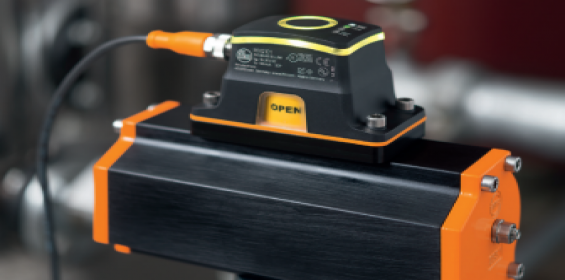Valve position sensors: making the right choices
Published: 04 April, 2022
If you think that valve position sensors are uninteresting devices and that there’s little to choose between them, read on, says Andy Walker of ifm electronic.
Valve position sensors have a vital role to play in almost every sector of industry and choosing the right valve sensor for the application can make a big difference to plant performance and reliability.
In almost any process plant, if a valve fails to open or close when required and the control system isn’t immediately alerted to the problem, the consequences are likely to be costly, disruptive and possibly dangerous. To help minimise these risks, valves are almost invariably fitted with position sensors to check that they have operated correctly before the process is allowed to proceed. It’s easy to see that these sensors perform a vital task so, when selecting them, it’s worth thinking carefully about which type of sensor is best for the job in hand.
This will, of course, depend on the type of valve being monitored and, to a lesser extent, on its role. For ordinary actuated valves, the usual solution was, for many years, to use cams mounted on the actuator shaft to operate mechanical switches which would signal open and closed status. In more recent times, the switches have been replaced by inductive proximity sensors which offer non-contact operation and are, therefore, completely wear free.
Today, an even more convenient solution is to use a dual sensor which combines the sensors for the valve open and closed positions in a single unit. This reduces mounting time and, if a version that supports a fieldbus interface such as AS-i is selected, it also reduces wiring complexity and installation time. These dual sensors are now available in a wide range of types, including hygienic versions for the food industry and NAMUR versions for hazardous area applications.
Sensor manufacturers typically supply target pucks – which replace the cams associated with mechanical switches – for use with their dual sensors. These are available in standard versions for valves with a 90º operating angle, and adjustable versions for valves with other operating angles. In addition, leading manufacturers offer mounting kits that allow the dual sensors to be used conveniently with manually operated valves.
Dual sensor solutions are an ideal choice for the majority of everyday valve applications but, in critical applications where a valve seat fault would be particularly problematic or expensive, there is a better choice: smart valve sensors. These work with a standard valve actuator, but continuously monitor the shaft position. The positional information can be accessed via an IO-Link interface, so that the control system can check, for example, for valve wear or failure to close fully because of the presence of debris on the valve seat.
The control system can also use the positional information to assess the opening and closing speed of the valve and thereby alert the plant operators to changes that might be indicative of developing faults before they progress to become outright failures. Options of this type make smart sensors particularly well suited to applications where a preventative maintenance regime has been adopted to minimise the risk of failure of critical plant items.
In addition to detailed and accurate positional information, the smart sensors also have digital outputs to indicate valve fully open and fully closed, as well as a third user-defined position. This makes them easy to integrate with virtually any type of control system.
The sensing solutions discussed so far are appropriate for rotary valves but for rising stem valves a different approach is needed. In such cases, the traditional solution was to use multiple sensors mounted at different heights along the path of the valve stem to monitor its position. This type of arrangement is inconvenient to install and hard to adjust.
A better solution is provided by a purposedesigned sensor in the form of a cylinder that encloses the stem and provides accurate information about its position. The best sensors of this type can provide positional information with a resolution of 0.2 mm across the entire measuring range, which is more than sufficient to detect developing problems due to wear and tear. As with the smart sensors discussed earlier, these cylindrical sensors for rising stem valves also provide switching outputs to allow easy control system interfacing.
The sensors discussed in this article provide reliable position sensing for almost any type of valve as well as, in many cases, additional information that is an invaluable aid for condition monitoring and preventative maintenance. Their installation and use can be made even easier, however, if the manufacturer offers them as complete kits that include, according to the sensor type, an actuator puck and connecting cable as well as the sensor itself. Not only does this make the items easier to order and stock, but enlightened manufacturers also charge less for these kits than the individual items purchased separately, so there is an immediate cost saving.
Choosing valve position sensors carefully can pay big dividends in terms of simpler installation, easier adjustment and better valve status information leading to enhanced plant up time. In many cases, the choice is straightforward, but some applications, especially where valve operation is particularly critical, are more challenging. In these cases, the best advice is to talk to a sensor manufacturer with an extensive product range, proven experience and demonstrable expertise.
https://twitter.com/ifmelectronic
https://www.linkedin.com/company/ifm/







